Wooden Doll No. 16
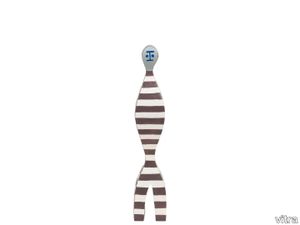
vitra > Styling
Alexander Girard originally created the Wooden Dolls (1952), a whimsical assortment of figures both joyful and grim, for his own home. Today they add a charming touch to any interior.
Embroidered Pillows - Double Heart, red
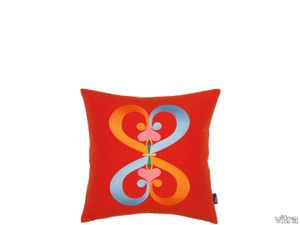
vitra > Styling
In 1957, Alexander Girard designed the interior of the legendary Miller House and decorated the so-called 'conversation pit' in the living room with specially embroidered pillow covers. The Embroidered Pillows feature motifs from the vast store of graphic images by Girard.
Miniatures Tulip Chair
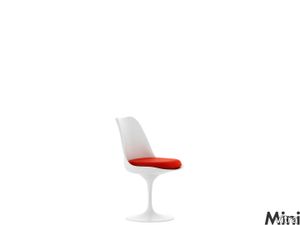
vitra > Styling
The Tulip Chair is one of a series of chairs, stools, and tables developed by Eero Saarinen within a five-year period. The characteristic feature of the series is that the supporting structure has been pared to a central supporting stem »like a wineglass« in order to emphasise the uniformity of table and chair.<br/><br/>Eero Saarinen describes the Tulip Chair: »The bases of tables and chairs in a typical furniture arrangement create an ugly, confusing, and restless world. I wanted to design a chair as an integrated whole once again. All important furniture of the past always had a holistic structure, from King Tut's chair to that of Thomas Chippendale. Today, we are parting ways with this holism with our predilection for plastic and laminated wood shells. I am looking forward to the point when the plastics industry will be capable of manufacturing the chair using just one material, the way I have designed it.«
Miniatures LCM
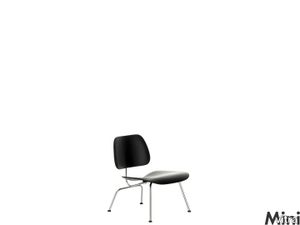
vitra > Styling
Charles Eames and Eero Saarinen designed a chair in 1940 with a new type of three-dimensional preshaped plywood seat for a competition held by the New York Museum of Modern Art. The chair did not go into production owing to a lack of technical know-how. It was very rare back then for plywood to be successfully pressed into a three-dimensional shape. In the years that followed, Charles and Ray Eames concentrated on developing a process that enabled plywood to be shaped as they wanted.<br/><br/>The »Plywood Chairs« DCW (Dining Chair Wood), LCW (Lounge Chair Wood) and the versions with metal legs, namely DCM (Dining Chair Metal) and LCM were the result of these years of experimentation. In 1945 Charles and Ray Eames again took up the idea of a seat made of formed plywood without, however, coming up with satisfactory solutions. As a consequence, they rejected the idea of a multifunctional seat and decided to treat seat and back as separate, freely articulated elements that were linked with each other via a backbone – the frame. Each component is therefore reduced to a clearly defined function which it fulfills with a minimum of materials being used. The rubber »shock mounts« glued onto the wood enable the seat and back to be connected to the frame.
Miniatures Antony
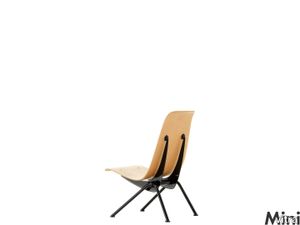
vitra > Styling
The architect, engineer and designer Jean Prouvé was intent both in his architectural and design work on employing highly-advanced metal working techniques to create innovative constructions and shapes. He played an influential role in developing a construction method for architecture based on lightweight prefabricated sections, and drew amongst other things on this knowledge of aircraft and car construction. In 1947, he set up his own company Ateliers Jean Prouvé, which not only produced these lightweight elements, but also his own furniture designs.<br/><br/>In 1955, Prouvé took part with the support of the French designer group Union des Artistes Modernes, in a competition for the furnishing of a student residence in Antony near Paris. Collaborating with Charlotte Perriand, he produced an exemplary furniture series for the leisure area, the cafeterias and a series of rooms in the student residence. His series included the chair shown here, which Prouvé had designed a similar version of for Strasbourg university as early as 1950.<br/>
Miniatures Lockheed Lounge

vitra > Styling
Marc Newson originally produced the Lockheed Lounge as the centerpiece of an exhibition of his pieces at the Roslyn Oxley Gallery in Sydney. It was widely acclaimed and was bought by the National Gallery of Australia. <br/><br/>Its concept was based »loosely, very loosely« on the chaise longue in Jacques-Louis David's 1800 portrait of Madame Recamier. »I had this image of a fluid, aluminium form. The shape was sculpted out of a piece of foam, the exact same way you'd create a surfboard. The only way to get the aluminium on was to beat little pieces of metal into shape with a wooden mallet and attach them with rivets. That's where the airplane metaphor came from. So I called it the Lockheed Lounge.
Miniatures Ribbon Chair

vitra > Styling
The enthusiastic, progressive atmosphere of the 1960s and Pierre Paulin's sculptural training were influential factors in the design of the Ribbon Chair. The curving loops of its shape, covered in colourful upholstery fabrics or psychedelic patterns by Jack Lenor Larsen, give it a captivating, futuristic appeal. Pierre Paulin himself interpreted the Ribbon Chair as a "coup de pied à la lune". A famous advertisement shows the Ribbon Chair on a runway with a jet taking off above it. <br/><br/>The seat, backrest and armrests of the chair have a unified metal frame that is completely covered with foam upholstery and stretch fabric. The seat is mounted on a lacquered pedestal made of pressed wood. The de-velopment of the Ribbon Chair was facilitated by technological innovations during the Sixties, which led to the production of inexpensive synthetic foams. This period also saw the introduction of novel elastic fabrics that could be used to envelop a complex contoured shape without folds or intricate seams. The biomorphic, slightly resilient seat of the Ribbon Chair allows a wide variety of sitting positions and provides a high degree of seating comfort.
Miniatures Rood blauwe stoel
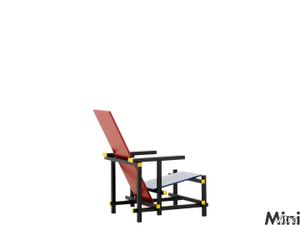
vitra > Styling
Gerrit Rietveld conceived of each piece of furniture as an ideal, abstract composition of surfaces and lines in space. The rigor with which he put this into practice makes »Roodblauwe stoel« a key object in modern furniture design. The form of abstraction Rietveld adopts here bears comparison to painter Piet Mondrian. <br/><br/>Mondrian, and later Rietveld, were among the artists and architects who grouped around Theo van Doesburg and his journal »De Stijl«, and whose radical concepts had a lasting impact on twentieth-century art. Rietveld reduced given realities to their linear and surface characteristics. Where Mondrian took landscapes as his model, Rietveld focused on the concept of a traditional, massive armchair, which he transformed into a geometric entity.
Miniatures Standard Chair
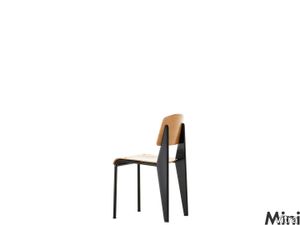
vitra > Styling
Designed in 1934 the Standard Chair is one of the quiet classics of history of design. Prompted by the furniture competition for the Cité Universitaire of Nancy, Prouvé worked on designs combining metal and wood during the early thirties. <br/><br/>He utilised the strength of steel for the base of Standard Chair. The back and the seat however, which come in direct contact with the sitter's body, are formed out of plywood. The quality of this chair is revealed in its structure and unassuming aesthetics.
Miniatures Stool (Model C)

vitra > Styling
Charles and Ray Eames received a commission to design the interiors of three lobbies in the new Time & Life Building at Rockefeller Center in New York City. In addition to outfitting these spaces, this major project encompassed the development of the comfortably upholstered Lobby Chairs and a group of stools made out of solid walnut. <br/><br/>The lathe-turned stools, which were also conceived by Ray to be used as small occasional tables, have distinctive individual profiles. The sculptural and decorative character of the stools makes the most striking impression when they are grouped together.These pieces were inspired by an African stool that stood in the living room of the Eames House, as shown in a photographic series by Monique Jacot from the year 1959.
Miniatures Tom Vac Chair
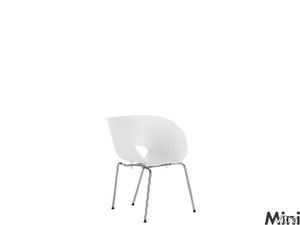
vitra > Styling
The Tom Vac Chair was first realized as one element in a sculpture consisting of 70 stacking chairs named »Totem«. Commissioned by the magazine Domus, it was set up in the centre of Milan during the Salone del Mobile in 1997.<br/><br/>The seat shell with the characteristic wave profile is based on earlier versions Ron Arad sketched for the dining room of a house in Tel Aviv. The first small series for »Totem« was created in just four months. Though it is a complicated metal to manufacture, vacuum-formed aluminium proved to be a suitable material.<br/><br/>In collaboration with furniture maker Vitra, for whom he had already produced the Well Tempered Chair back in 1986, Ron Arad developed, within a very short time, a version of the Tom Vac Chair suitable for mass production. Seen within the context of Arad's complete work, which is largely characterized by »one offs«, the chair is something of an innovation by virtue of its industrial and by extension inexpensive production. While the design of the Tom Vac Chair only deviates minimally from the first plan, the flexible seat shell of polypropylene offers a high degree of comfort.
Miniatures Barrel Chair
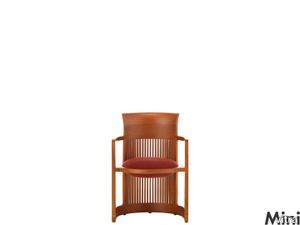
vitra > Styling
Originally designed by Frank Lloyd Wright in 1904 for the D. D. Martin House in Buffalo, New York, this iconic chair was an embarkation from his earlier linear furniture designs, due to its round shape.<br/><br/>Original features included a flared backrest, square spindle supports and a cushioned double-sided circular seat. In 1937, Frank Lloyd Wright re-created the Barrel Chair design in a larger version with other design modifications for the residence of Herbert F. Johnson, known as »Wingspread«, to accommodate the expansive rooms and towering ceiling heights.
Miniatures Bocca
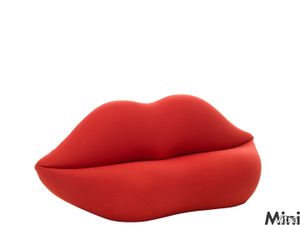
vitra > Styling
The use of cold-expanded polyurethane makes traditional methods of constructing furniture redundant. One series of sculptural furniture objects stands out amongst the furniture designs of the »Studio 65« group, since it makes radical use of the freedom of design allowed by this new material. And the style of this furniture demonstrates characteristics originating in the pictorial arts of the 1960s: the softening of a Claes Oldenburg, the naive stylization to be found in comics and commercial art, or the giant, intoxicated dimensions assumed by 1960s objects.<br/><br/>Alongside an armchair in the shape of a pillared Greek temple and a Babylonian shrine as a playsystem for children, Studio 65's contribution to the »radical design« included a sofa in the shape of a woman's mouth. The subtitle Studio 65 gave to its Sofa Bocca: »alias lips, alias Marylin«, is a reference to the inspiration for this design and its symbolism. Salvador Dalí, to whom the idea for a design of this kind has been attributed, was quoted by Studio 65 in this context as follows: »Objects with a symbolic function leave no room for formal considerations. They are characterized only by each individual's idea of love and are above any notions of shape.«<br/>
Wooden Doll No. 20
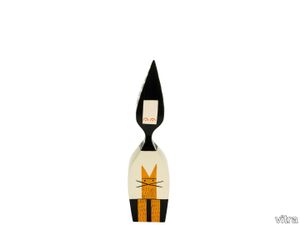
vitra > Styling
Alexander Girard originally created the Wooden Dolls (1952), a whimsical assortment of figures both joyful and grim, for his own home. Today they add a charming touch to any interior.
Miniatures Butterfly Stool
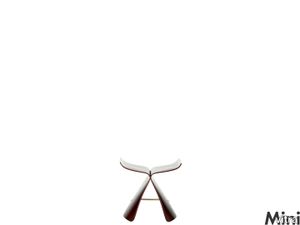
vitra > Styling
As a student in the 1940s Sori Yanagi accompanied Charlotte Perriand on her trips through Japan, thus becoming familiar with the classical Moderns. It is possible that this is what aroused Yanagi's interest in seating, something which does not exist in Japanese culture. Even today a large number of Japanese households manage without any kind of seats, even in the cities, since it is traditional to sit on the floor on tatami mats.<br/><br/>In view of the above Yanagi's Butterfly stool can be described as unusual on a number of counts. The designer adopts a familiar Western shape and combines it with a technique employed by Charles and Ray Eames which involves using bent plywood for industrial manufacture. The stool is unusually cleverly constructed, with two identical shapes connected axisymmetrically by means of two screws underneath the seat and a screwed on brass rod. This creates a shape reminiscent in some ways of the torii (gates) to Shinto shrines, which gives the stool an oriental look. At the same time it calls to mind the wings of a butterfly, hence its name. The stool was awarded the gold medal at the 1957 Milan triennial.<br/>
Miniatures Favela
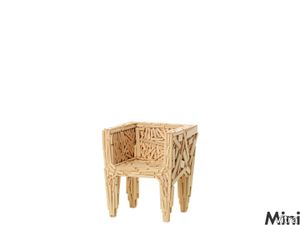
vitra > Styling
The Favela armed chair is one of the most striking works by the Brazilian designers Fernando and Humberto Campana. According to a statement by the brothers, the architecture of the typical shanty towns in their native country was the inspiration for the design and name of this extraordinary item of seating furniture. <br/><br/>Like the majority of hut-like dwellings, the favela is also nailed and glued together from oddments and waste materials. The Campanas made use of small, differently-sized strips of wood, as are produced in abundance in every joinery, for their representative chair.<br/><br/>In the Favela, they prove that objects of singular elegance and beauty can even originate from apparent mundane, worthless materials. Over and above this, the Favela throws a new light on the dynamic relationship between a one-off design and a mass-produced product. Although every chair is made from the same material and to an identical construction plan, each finished article still retains its individuality in the detail.
Akari 45A
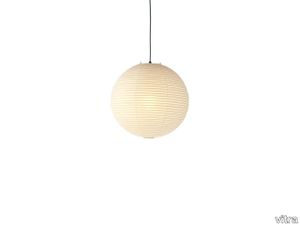
vitra > Styling
The Akari Light Sculptures (1951) by Isamu Noguchi are a series of luminaires, handcrafted from traditional washi paper by Japanese artisans. ‘The harshness of electricity is thus transformed through the magic of paper back to the light of our origin – the sun.’ (Noguchi)
Akari BB3-55DD
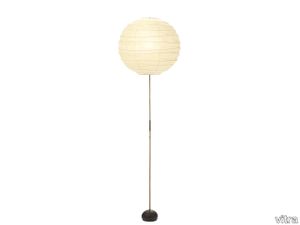
vitra > Styling
The Akari Light Sculptures (1951) by Isamu Noguchi are a series of luminaires, handcrafted from traditional washi paper by Japanese artisans. ‘The harshness of electricity is thus transformed through the magic of paper back to the light of our origin – the sun.’ (Noguchi)
Akari E
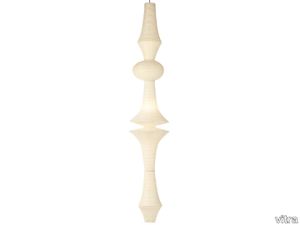
vitra > Styling
The Akari Light Sculptures (1951) by Isamu Noguchi are a series of luminaires, handcrafted from traditional washi paper by Japanese artisans. ‘The harshness of electricity is thus transformed through the magic of paper back to the light of our origin – the sun.’ (Noguchi)
Akari UF1-H
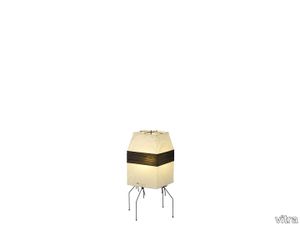
vitra > Styling
The Akari Light Sculptures (1951) by Isamu Noguchi are a series of luminaires, handcrafted from traditional washi paper by Japanese artisans. ‘The harshness of electricity is thus transformed through the magic of paper back to the light of our origin – the sun.’ (Noguchi)
Wall Clocks - Turbine Clock
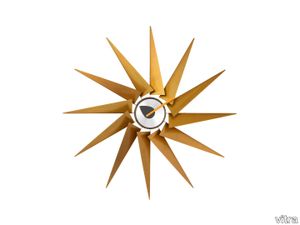
vitra > Styling
With his collection of Wall Clocks (1949-1960), George Nelson conceived a wide array of timepieces, many of which have since become icons of 1950s design.
Wall Clocks - Wheel Clock
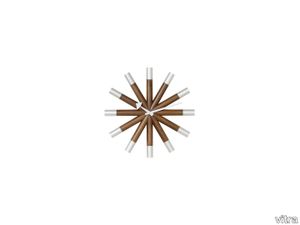
vitra > Styling
With his collection of Wall Clocks (1949-1960), George Nelson conceived a wide array of timepieces, many of which have since become icons of 1950s design.
Wooden Doll No. 9
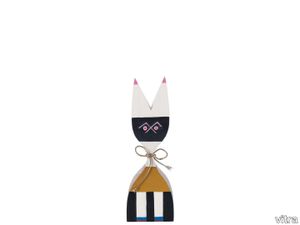
vitra > Styling
Alexander Girard originally created the Wooden Dolls (1952), a whimsical assortment of figures both joyful and grim, for his own home. Today they add a charming touch to any interior.
Wall Clocks - Polygon Clock
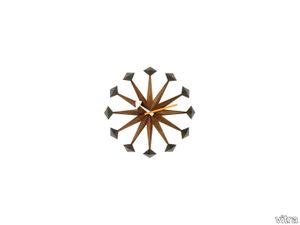
vitra > Styling
With his collection of Wall Clocks (1949-1960), George Nelson conceived a wide array of timepieces, many of which have since become icons of 1950s design.
Coffee Mugs - Love Heart, crimson

vitra > Styling
The designer and architect Alexander Girard created a number of restaurant interiors, for which he also developed coordinated objects and accessories. The motifs featured on the Coffee Mugs have their origins and inspiration in these rich and varied environments.
Living Tower
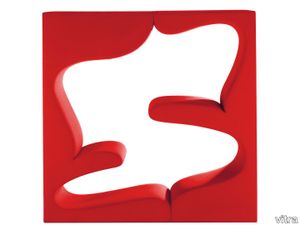
vitra > Styling
The organically shaped Living Tower furniture sculpture by Verner Panton can be used on four different levels. Over two metres high, the appealingly upholstered seating tower has a stable frame made of birch plywood. The cleverly arranged interior niches can be used in sitting and reclined positions, encouraging communication and relaxation.
Herringbone Vessels - Tray
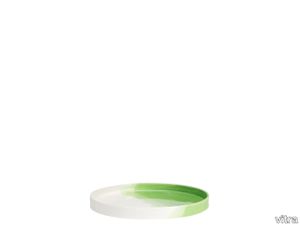
vitra > Styling
The Herringbone Vessels are created by repeatedly immersing ceramic bowls and vases in a coloured glaze. This process yields a pattern with an intrinsic logic, determined by the dipping angle as well as the shape and weight of the piece. As the dyeing process is performed entirely by hand, each bowl and vase in the Herringbone Collection is a unique object.
Eames Elephant
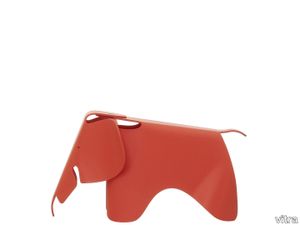
vitra > Styling
The elephant that Charles and Ray Eames initially developed out of plywood in 1945 is available in plastic – as a toy or decorative object in a variety of colours, and not just for children's rooms.
Akari 24N
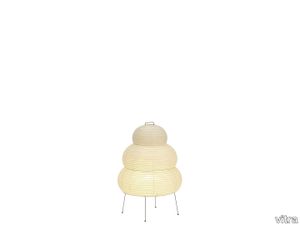
vitra > Styling
The Akari Light Sculptures (1951) by Isamu Noguchi are a series of luminaires, handcrafted from traditional washi paper by Japanese artisans. ‘The harshness of electricity is thus transformed through the magic of paper back to the light of our origin – the sun.’ (Noguchi)
Elephant Pad
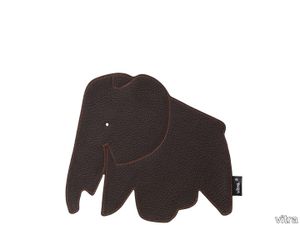
vitra > Styling
Designer Hella Jongerius drew her inspiration for the Elephant Pad from the Eames Elephant by Charles and Ray Eames. The charming mouse pad is made from high-quality leather: to make sustainable use of leather left over from the production of upholstered furniture, Vitra uses it to craft small objects – such as the Elephant Pads. These are available in the six colours of leather most frequently used in production and have a soft and pleasant feel.
Terracotta Pot, medium
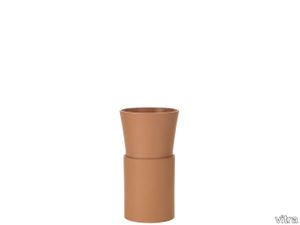
vitra > Styling
The column-like forms of the different sized Terracotta Pots serve as pedestals for the plants they hold, elevating them and giving them more presence in the room.
Eames Elephant (Plywood)
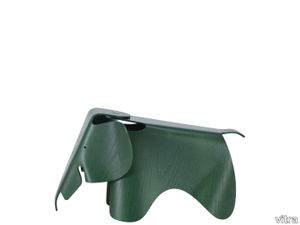
vitra > Styling
Charles and Ray Eames developed a toy elephant made of plywood in 1945; however, this piece never went into production. One prototype was shown at the Museum of Modern Art in New York in 1946 and still survives in the Eames family archives today. After issuing a first limited edition in 2007, Vitra commenced serial production of the Eames Elephant in plywood in 2018.<br/><br/>The Eames Elephant in plywood is available in cherry wood or – as a special numbered and labelled series – in grey-stained ash.<br/><br/>The Eames Elephant additionally exists in plastic, ideal for children, as well as in a smaller version also in plastic, Eames Elephant (small), with both available in a variety of colours.<br/><br/>The Eames Elephant in a dark green stained finish is part of the Eames Special Collection 2023 and is only available until the end of January 2024.
Soft Seats Outdoor
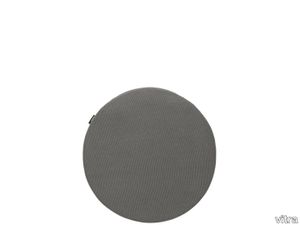
vitra > Styling
Soft Seats Outdoor are loose seat cushions for outdoor use. They provide pleasant comfort for unupholstered chairs and are available in three shapes to ensure there is a suitable cushion for every chair model. <br/><br/>The quick-drying, antibacterial cover fabric of Soft Seats Outdoor is resistant to light, water and mould and exists in three colours. The padding measures two centimetres in thickness and consists of water-permeable polyurethane foam (Oeko-Tex). The covers have zip fasteners and are easily removable – to be washed at 30 degrees or replaced, if needed.
Check Shower Curtain
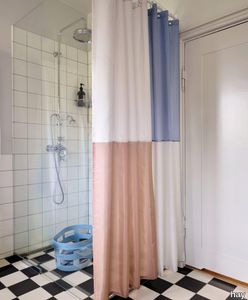
hay > Styling
HAYs Check Shower Curtain features graphic checks in contrasting colours that add a contemporary touch of colour to a bathroom. Made in recycled polyester with metal grommets the curtains are available in different versatile designs.
Basket (Recycled)
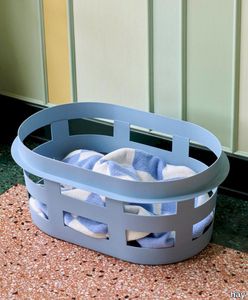
hay > Styling
Designed by BIG-GAME for HAY Baskets graphic lines and subtle colours create a versatile and visually appealing storage basket suitable for keeping all kind of objects tidy and organised. Made in 100% post-consumer recycled polypropylene and available in several sizes it can be used in any room in the house.
Mono Wash Cloth
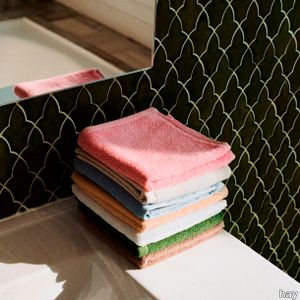
hay > Styling
Crafted in durable cotton with a soft frott texture Mono Towels are a range of bathroom towels that feature a classic timeless design with an embossed HAY logo. Comprising a selection of different sizes in muted and bold colours the towels can be matched together or mixed in different colours with other HAY towels. OEKO-TEX STANDARD 100 cert. No 2176-345 DTI.
Frotté Stripe Hand Towel
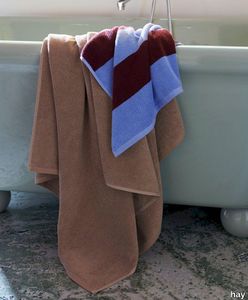
hay > Styling
Crafted in soft absorbent cotton the Frott Striped Towel series is designed by Amanda Borberg and features horizontal stripes in contrasting colours. An everyday essential the towels come in different colour combinations and can be matched or contrasted with other HAY towels. OEKO-TEX STANDARD 100 cert. No 2176-345 DTI.
Outline Robe
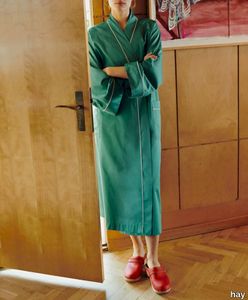
hay > Styling
Designed for HAY by Danish designer Tilde Bjerregaard the Outline Pyjama Collection is a new collection of sleepwear that focuses on quality and attention to craftsmanship. Outline combines uncluttered lines and curated colours with a contrast trim to create a refined take on an everyday essential. Made in drapy organic cotton that feels soft and smooth against the skin the Outline Pyjama Collection comprises short- and long-sleeved shirts shorts long trousers and a belted robe. Designed with optimal versatility in mind the collection comes in two different sizes SM and ML making it equally suitable for using at bedtime or relaxing in comfort around the home. All items are available in different colour options carefully selected for their ability to be worn alone or together. OEKO-TEX STANDARD 100 cert. No 22.HTR.46979 HOHENSTEIN HTTI.
Été Pillow Case
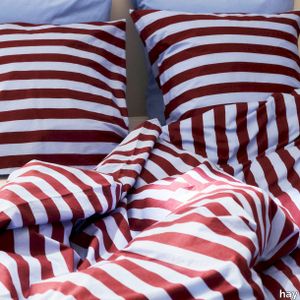
hay > Styling
Crafted in crisp soft cotton with contrasting stripes t Pillow Case is a HAY x Amanda Borberg design collaboration that brings to mind hot summery days with sandy beaches and fresh sea air. Available in a variety of colours. OEKO-TEX STANDARD 100 cert. No 2176-345 DTI.
Flare Stripe Milk Small
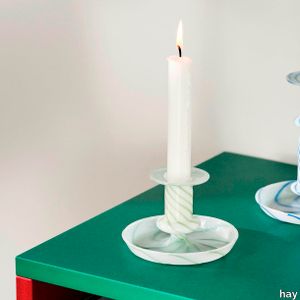
hay > Styling
Coloured borosilicate glass creates an elegant and distinct way to display candles in HAYs Flare Candleholder. Available with a contrast- or tonal-tinted edge or spiralled pattern in a choice of colours. Ideal for using with HAY candles on a windowsill or table to create ambience in the home.
Flare Stripe
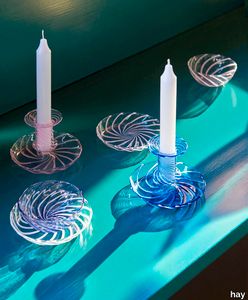
hay > Styling
Coloured borosilicate glass creates an elegant and distinct way to display candles in HAYs Flare Candleholder. Available with a contrast- or tonal-tinted edge or spiralled pattern in a choice of colours. Ideal for using with HAY candles on a windowsill or table to create ambience in the home.
Flare Tall Rainbow
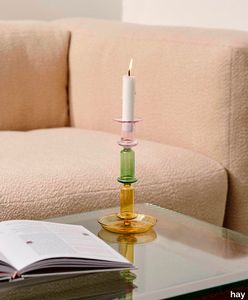
hay > Styling
Coloured borosilicate glass creates an elegant and distinct way to display candles in HAYs Flare Candleholder. Available with a contrast- or tonal-tinted edge or spiralled pattern in a choice of colours. Ideal for using with HAY candles on a windowsill or table to create ambience in the home.
Flowerpot With Saucer
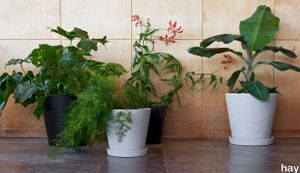
hay > Styling
Flowerpot is a series of minimalist flowerpots with matching saucers. They are made of lightweight and durable polystone and feature an inside coating for extra protection. The drainage hole at the bottom allows any excess water to escape into the saucer. Suitable for indoor and outdoor use though not outside during winter months in freezing weather. Available in different sizes and colours.
Phanta Plant Hanger
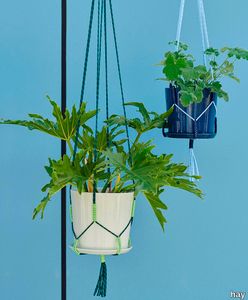
hay > Styling
Designed by the Danish design brand Phanta the Phanta Plant Hanger is a colourful 70s-inspired macrame plant holder that can be suspended from a ceiling or shelf. Its flexible design can hold a wide variety of flowerpots baskets and containers offering an original and decorative solution for displaying plants and other ornaments. Handmade from recycled polyester it is available in different colour options.
Sobremesa Stripe Vase
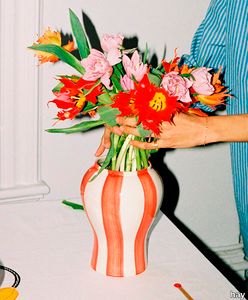
hay > Styling
Part of a design collaboration between HAY and artist Laila Gohar that celebrates the joy of meeting family and friends over a good meal the Sobremesa Stripe Vase is a decorative vase designed to add ambiance to any table setting. Hand-painted in stoneware with a colourful striped pattern that gives each jug a unique quality it can be used for bunches of flowers blossoming branches or storing kitchen utensils. Available in different sizes and designs.
Bottoms Up Vase

hay > Styling
Designed by Ingrid Aspen Bottoms Up Vase is crafted in coloured glass and features an elegant neck balanced upon a domed base. Available in two sizes and a choice of colours.
Wall Clock
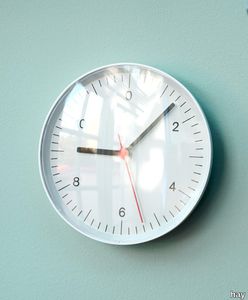
hay > Styling
Originally designed in 2008 by Jasper Morrison the iconic Wall Clock has now found a new home with HAY as a result of a collaboration with the renowned British designer. The clocks clean uncluttered design reflects Jaspers talent of creating straightforward and relevant items that fit seamlessly into everyday surroundings using functional industrial design without the need for any superfluous details. The clock is easy to hang and features a smooth second hand movement that makes no ticking sound. Available in selected colours chosen for their ability to adapt to any space while complementing the HAY universe.
Borosilicate Borosilicate Mug
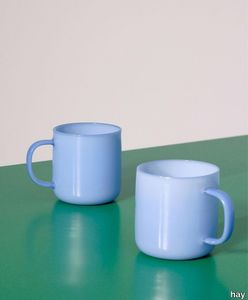
hay > Styling
Crafted in durable borosilicate glass the Borosilicate Mug has a functional design in beautiful jade colours. Featuring a straight body and a round symmetrical handle it is an elegant upgrade to your everyday kitchen essentials. It comes in a pack of two and is available in different colours.
Sowden Juicer
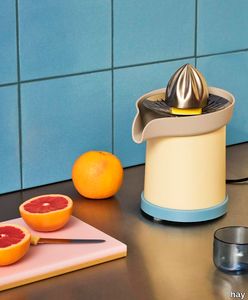
hay > Styling
Featuring the same signature colours as the rest of HAYs George Sowden kitchen collection the Sowden Juicer brings function and colour to any kitchen. The electric design effectively squeezes citrus fruits effortlessly providing fresh pulp-free juice... Made in durable plastic and stainless steel the Sowden Juicer is easy to disassemble and clean after use.
Sowden Toaster
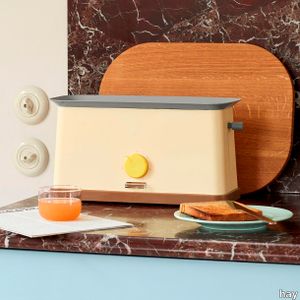
hay > Styling
The Sowden Toaster shares the same distinctive family of colour combinations as the rest of George Sowdens collection making a statement in any kitchen. Designed to be durable in plastic and stainless steel the Toaster is easy to clean and features a browning dial for adjusting the toasting level to perfection. Available in different colour options.